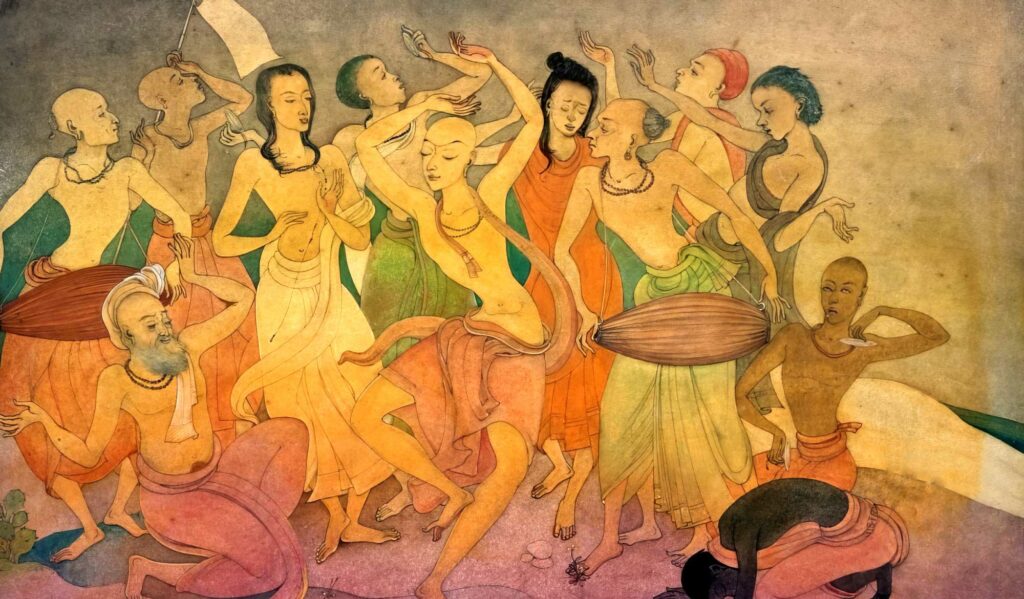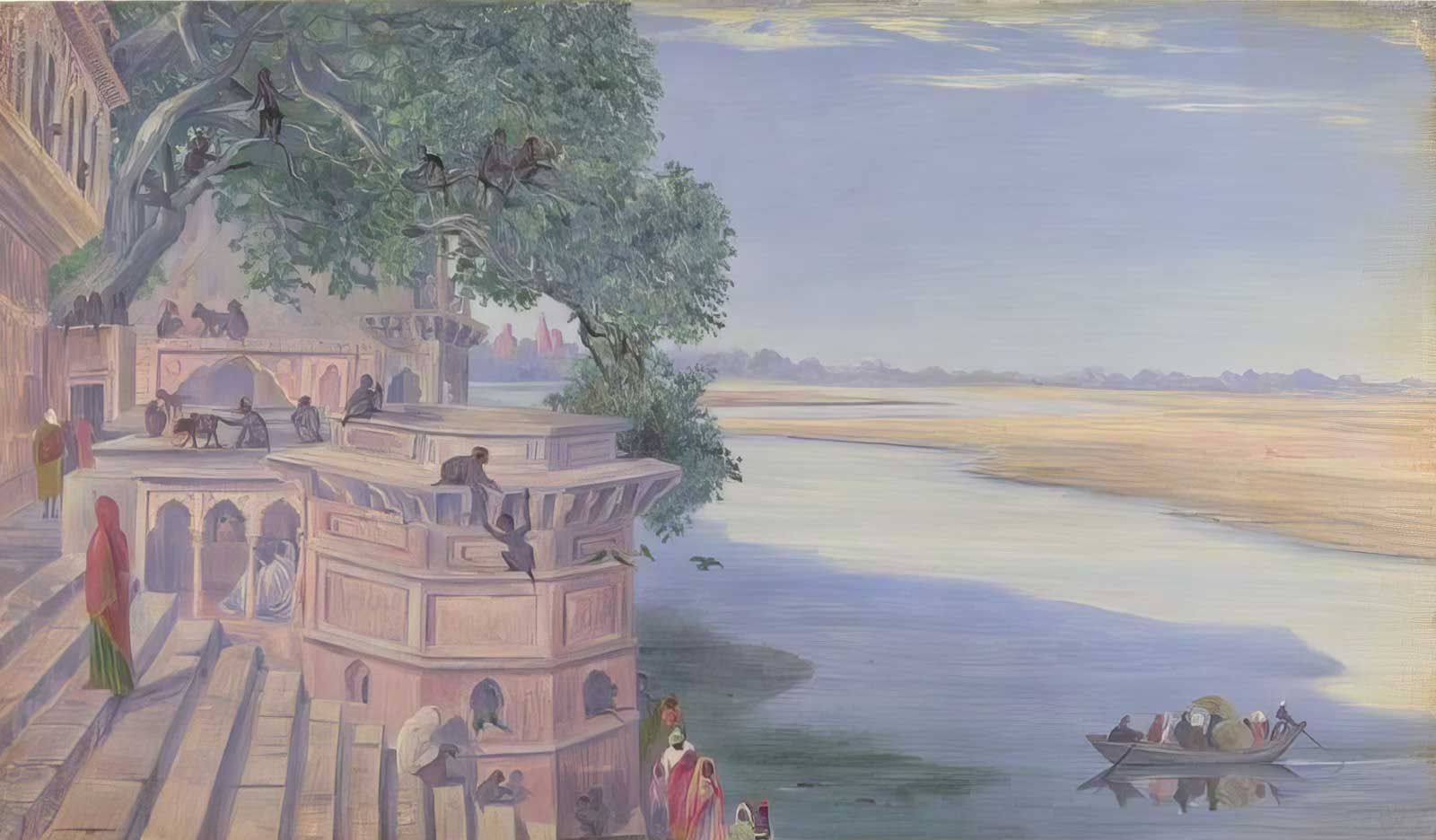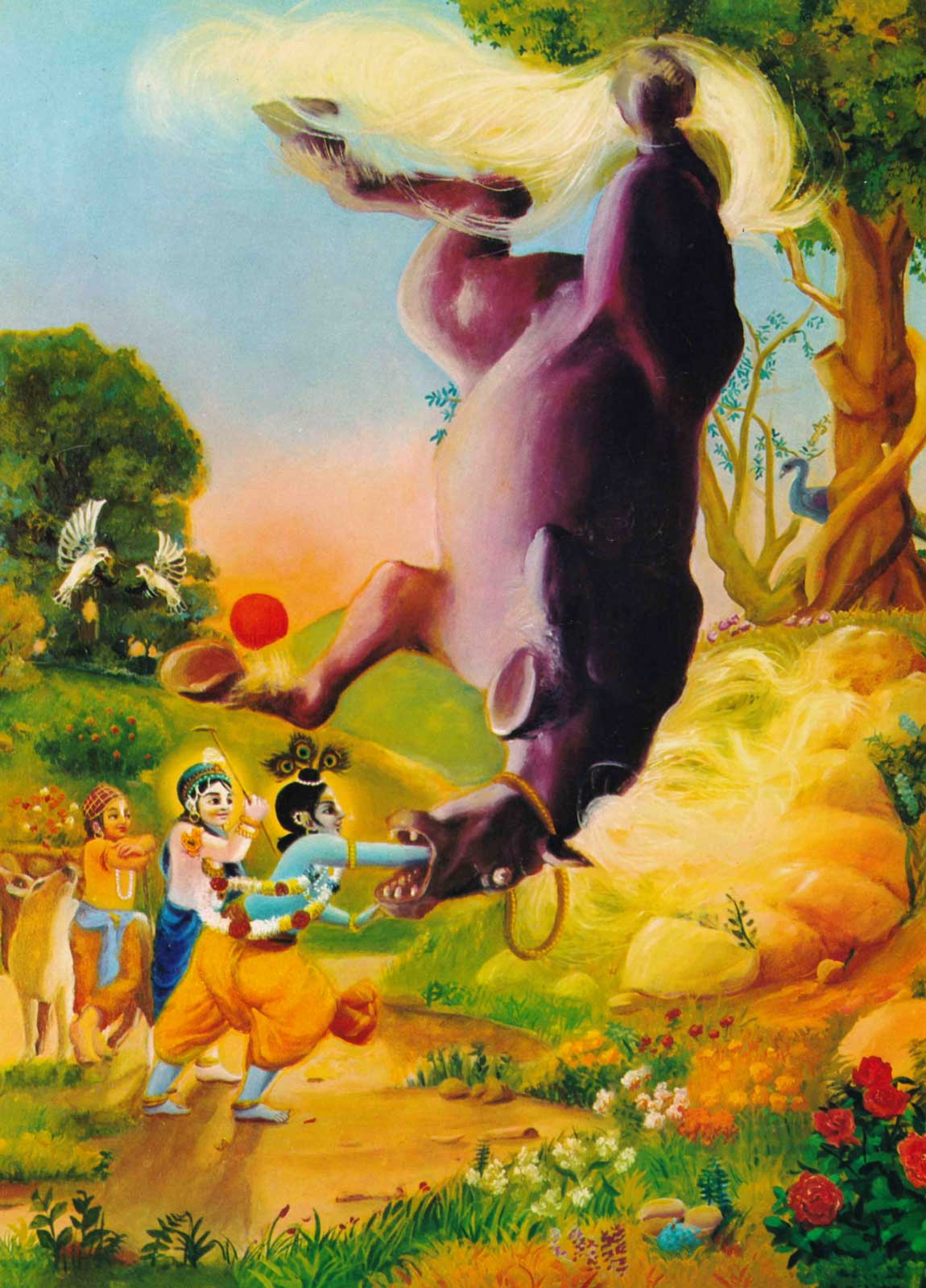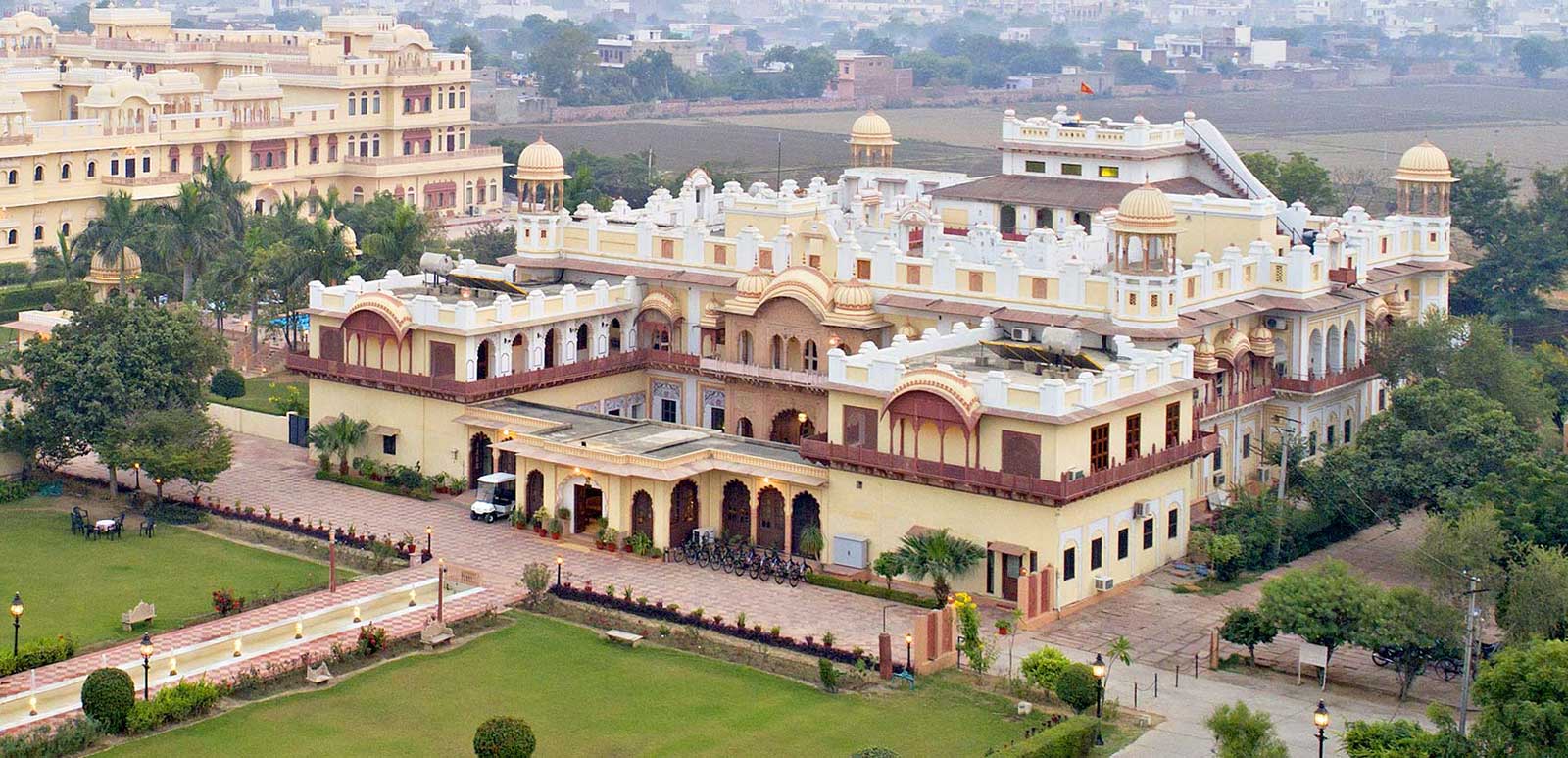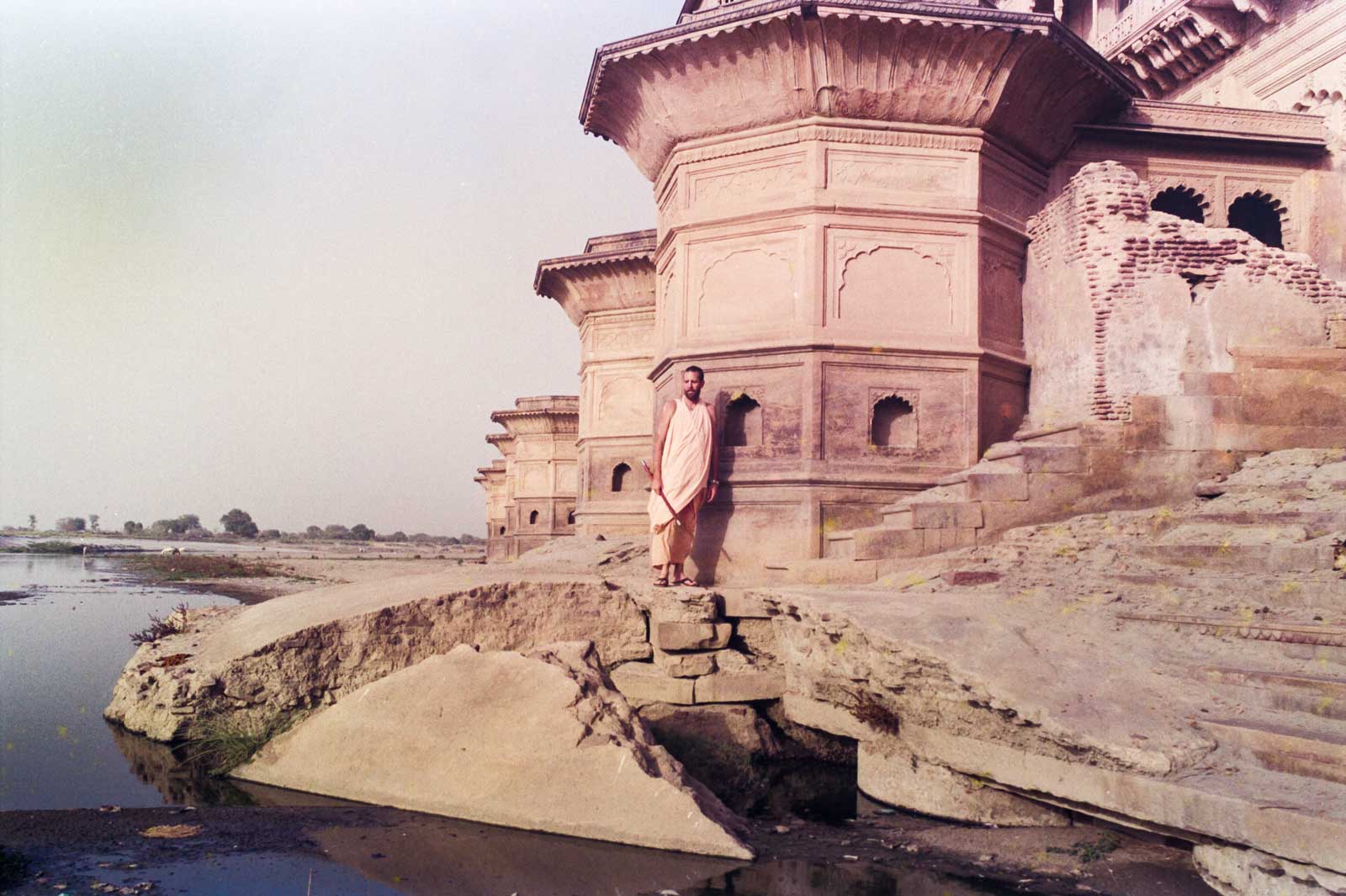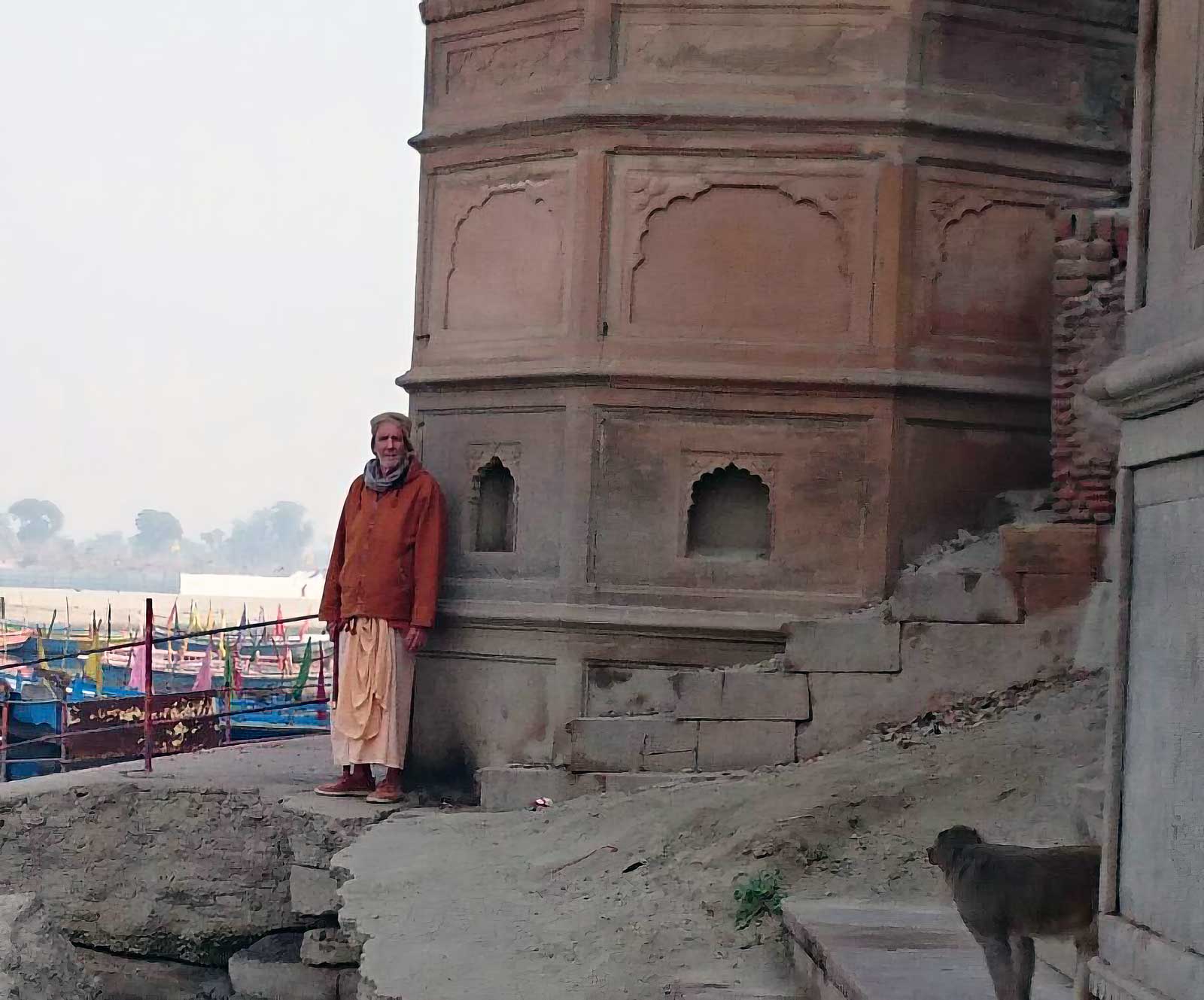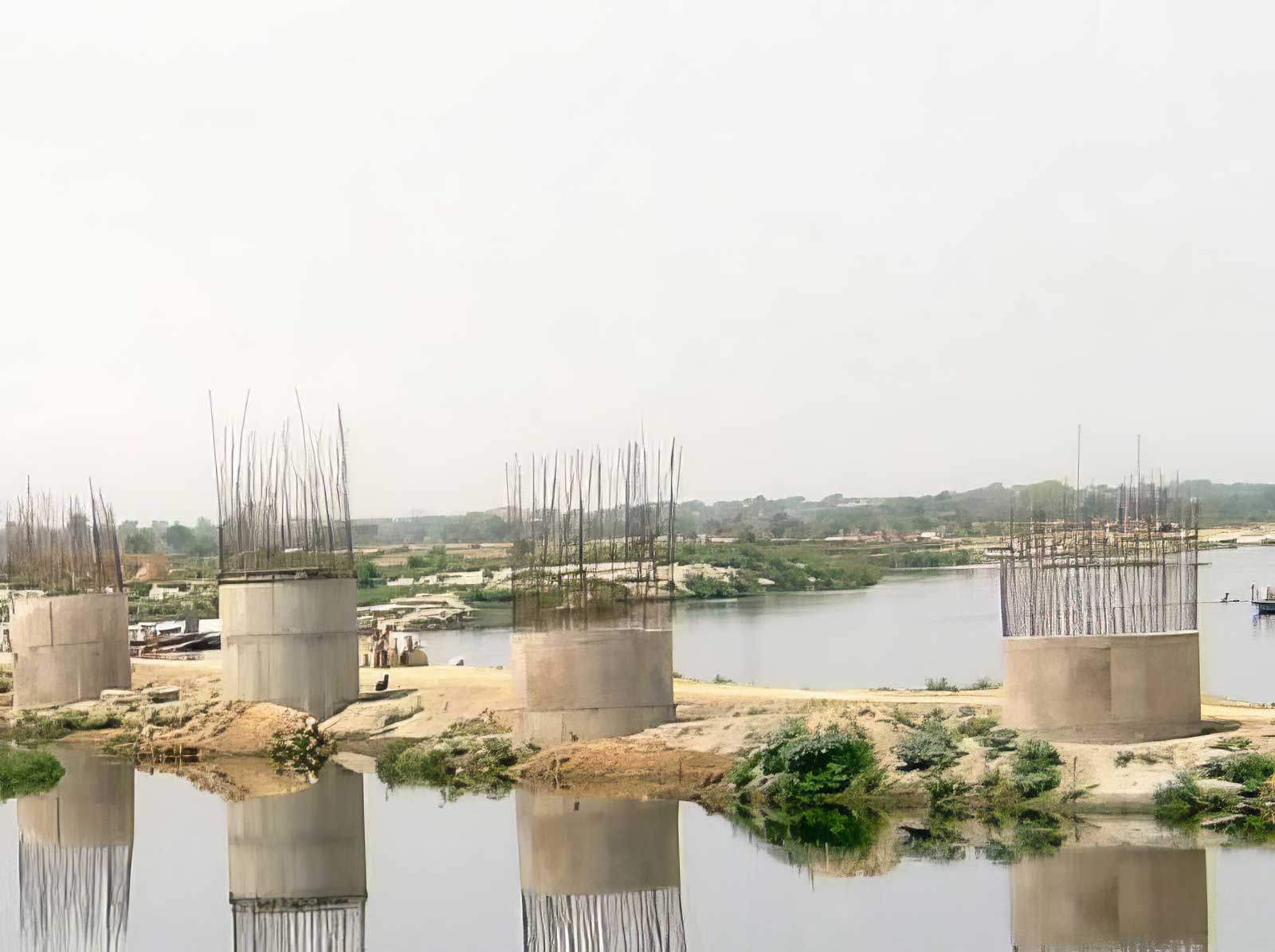Overview
Continuing with our pilgrimage series, this week Śrīla Narasiṅgha Mahārāja takes us to Keśī Ghāṭā where he tells us about Madhumaṅgala’s meeting with the Keśī demon, what Keśī represents, and how Śrīla Prabhupāda almost acquired Keśī Ghāṭa. Mahārāja also narrates his own experience. This article has been adapted from a number of talks and articles by Narasiṅgha Mahārāja.
Along the parikramā-mārga in Vṛndāvana, there are many ghāṭas. A ghāṭa is a place where people would take bath and meet, and sometimes take their cows and buffaloes to drink the water of the Yamunā. Keśī-ghāta is one of those ghāṭas and is probably the most famous – at least it is the most recognisable because of the architecture.
Keśī was a asura who had been sent by Kaṁsa to kill Kṛṣṇa when He was young. Kaṁsa sent many demons to kill Kṛṣṇa, but of course, none of them were successful. Keśī was a horse-demon – he took the form of a giant horse, and when he came to Vraja, he was stamping around, digging the ground up with his hooves, and making a big ruckus.
(Keśī Ghāṭā depicted in British Lithograph Painting)
Madhumaṅgala and the Keśī Demon
First, what happened is that the day that Keśī came to Vṛndāvana, Kṛṣṇa sat to take lunch with all the cowherd boys. One of those boys was Kṛṣṇa’s brāhmaṇa friend Madhumaṅgala. Madhumaṅgala would sometimes make funny noises and make everyone laugh, and he would tell Kṛṣṇa, “I will give you my aśīrvāda, my blessing, if you give me some laḍḍus!”and then Kṛṣṇa would give him some laḍḍus from His tiffin. So that day, Madhumaṅgala told Kṛṣṇa, “Today, if You give me more laḍḍus, I will give my blessings and Rādhārāṇī will be happy with You.”
Then Kṛṣṇa ridiculed him and told the cowherd boys, “What is the potency of his aśīrvāda? We give this fat brāhmaṇa so many laḍḍus every day, but what effect do we get? Better we keep them for ourselves!”
Madhumaṅgala got angry, “All the villagers give You laḍḍus, and I know why – You cannot fool me. It is because Your dress is so nice. Because Your mother dresses You so nicely, they are enamoured and they give You laḍḍus. But if I had Your dress – Your peacock feather, Your dhoti, all those things that bewilders them, then they would give me all their laḍḍus!”
Then Kṛṣṇa said, “Oh, so you want My dress?”
Madhumaṅgala said, “Yes!” He thought, “This is my chance. I’ll get Kṛṣṇa’s dress and I’ll be off to the village. They will think that I am Kṛṣṇa. I will then collect many laḍḍus from all the ladies in Vṛndāvana.”
Then they traded dresses, Kṛṣṇa remained in the forest with His cowherd friends and Madhumaṅgala started for Vṛndāvana to go door to door and collect laḍḍus from the gopīs there.
At the same moment, the Keśī demon arrived in Vṛndāvana to kill Kṛṣṇa. Before leaving Mathurā, Keśī asked Kaṁsa, “There are many boys in Vṛndāvana. How will I know which of them is Kṛṣṇa?”
Kaṁsa said, “You will recognise him by His yellow dhoti, He wears a turban with a peacock feather, and He carries a flute. No one else dresses like He does.” So Keśī came stomping into Vṛndāvana and the first thing he saw was Madhumaṅgala marching towards the village. Keśī saw him and thought, “There is Kṛṣṇa!” and he charged, spun around and kicked Madhumaṅgala in the chest with his hindlegs and he went flying. Some say that Keśī actually kicked him, and some say he missed and the breeze from Keśī’s charging blew Madhumaṅgala back and he fell down. Anyhow, rubbing his chest, he quickly ran back to Kṛṣṇa and threw His turban, yellow dhoti and everything on the ground and said, “I don’t want these things!”
Kṛṣṇa asked, “Why? What happened?”
Madhumaṅgala told everybody what happened and they began to laugh. Then Kṛṣṇa put His clothes back on and went to deal with the Keśī demon. When Keśī saw the real Kṛṣṇa, he charged at Him, but Kṛṣṇa grabbed him by the back legs, whirled him around His head a few times, and threw him a few miles away. When Keśī recovered, he charged at Kṛṣṇa again with his mouth open – this time, Kṛṣṇa pushed His arm all the way down Keśī’s throat and choked him to death. The place where Kṛṣṇa killed him is Keśī Ghāṭa.
(Kṛṣṇa killing the demon Keśī)
The Anarthas Represented by Keśī
The Keśī demon represents the illusion of being a great devotee or a great ācārya. Keśī personifies the practitioner’s conception of being more expert than others in devotional service, lording it over others and material pride. When he comes to Vraja he creates a great disturbance. As a Keśī-like devotee gradually begins proclaiming his own superiority, a mentality of disrespect for the Lord arises and the devotee falls from his position. Therefore, it is most important to prevent this evil mentality from entering the heart. Even if one is expert in devotional service, a Vaiṣṇava will never give up the quality of humility.
Śrīla Prabhupāda and the Mahārāja of Bharatpur
The royal family of Bharatpur built Keśī Ghāṭa. At one time, the kings of Bharatpur and Jaipur basically managed the whole of Vraja and gave protection to it. Back in the early 70’s, Śrīla Prabhupāda returned to India and was staying at Rādhā-Dāmodara Temple, and made an arrangement with the Mahārāja of Bharatpur for his disciples to stay at Keśī Ghāṭa. At that time, even though the royal families in India had lost their power, the Mahārāja of Bharatpur was still very influential, very rich, and owned a lot of property in Vraja. There was talk that the Mahārāja wanted to donate Keśī Ghāṭa to Śrīla Prabhupāda, so the Iskcon temple was originally going to be there.
One day, some of the Mahārāja’s men showed up at Keśī Ghāṭa and told Acyutānanda Swami, the leading sannyāsī there, “The Mahārāja of Bharatpur has sent a gift.” The gift was a big solid silver jhulana, a swing for the Deities. Now, in spite of being very rich, the Mahārāja of Bharatpur also had a reputation of being cracked. For example, he would give somebody a ring, and then a few days later say, “Oh, my ring is missing!” Then he would see that person wearing the ring and shoot him! He had such a reputation.
So when his men showed up saying, “The Mahārāja is gifting this jhulana,” Acyutānanda refused it.
Again, they said, “No, the Mahārāja is giving it as a gift.”
But again, Acyutānanda told them, “No, no, no, we can’t take it!”
That evening, when Acyutānanda and the devotees came to see Śrīla Prabhupāda at Rādhā-Dāmodara, they told him, “Today the Mahārāja of Bharatpur sent one gift.”
Prabhupāda asked, “Oh, what did he send?”
“One big silver jhulana.”
Prabhupāda smiled, “Oh, that is very nice.”
Then Acyutānanda told, “But we didn’t take it, Prabhupāda.”
Prabhupāda said, “What??”
“No, we sent it back.”
Prabhupāda shook his head, “You have ruined everything! All is lost. He will be insulted. He sent a gift and you didn’t take it.”
Acyutānanda explained, “No, it’s okay – I know the Mahārāja. I have been to his palace many times. I’ll go there and explain.”
Prabhupada said, “No, everything is lost!”
Acyutānanda went to the palace, and previously when he would come, the guards would just open the gates and let him through. This time when he came, as he approached, they put their hands on the hilt of their swords and stopped him. He told them, “I’m coming to see the Mahārāja.”
The guards said, “No!”
In fact, the Mahārāja had told them, “If he comes inside, cut his head off!”
So, Acyutānanda waited outside, and after some time, the Mahārāja’s big imported Lincoln Continental came out of the gate. Acyutānanda jumped up and shouted, “Mahārāja! Mahārāja!” but the car drove off. Acyutānanda had a rented Ambassador and he jumped in and told the driver, “Chase it! Chase it!” When the Ambassador finally caught up with the Lincoln and pulled up alongside it, Acyutānanda rolled down his window and was waving his hands shouting, “Mahārāja! Mahārāja!” but the Mahārāja of Bharatpur didn’t even look at him – he tapped his driver on the shoulder with his walking stick and the car sped off, leaving the Ambassador in the dust! I don’t think any devotee ever managed to see the Mahārāja of Bharatpur again. So, Śrīla Prabhupāda was right – all was lost. Keśī Ghāṭa might have been Prabhupāda’s temple if the devotees had accepted that silver jhulana.
Thirty years later, I met the man who had come to deliver the jhulana on behalf of the Mahārāja. His name was Ashley and I heard his side of the story. I asked him, “After the devotees refused the jhulana, what did you do?”
He said, “I went to Mathurā and phoned the Mahārāja and told him that the Swami refused to accept his gift.”
Then I asked, “What did the Mahārāja say?”
Ashley replied, “He was really angry. He told me, ‘Throw it in the Yamunā!’”
I asked, “And did you?”
He said, “No, no, no! I kept it, because later, he may ask me , ‘Where is that jhulana?’ ‘and if I told him I threw it in the river, he might kill me!”
That’s the problem dealing with a cracked king!
(The Bharatpur Palace)
Narasiṅgha Mahārāja and Keśī Ghāṭa
When I first came to stay in Vṛndāvana, before we established Rūpānuga Bhajana Āśrama, I tried to acquire Keśī Ghāṭa – the problem was that I didn’t have any money. Anyhow, I went to see the Mahārāja at his palace in Bharatpur, hoping that he might have softened a bit and would donate it to me. At that time he was old and was locked up at the top of the palace – it was like something out of an old story. I ended up dealing with his son, the prince, but he kept me stalling in the waiting room for six or seven hours. There were brokers there, and he was selling all the paintings off the wall, the furniture, the pool tables, chandeliers etc. Every so many hours, the prince would walk in, finalise a deal, pack the money in a bag, and they would take all the stuff. The brokers told me, “Oh, he has go-downs with so many things – even old carriages with inlaid silver and ivory!”
Eventually, around lunchtime, I was strolling around the back of the palace and I saw a servant with a tray coming from the kitchen. I asked him, “Excuse me, where are you going?”
He answered, “I’m going to give the Mahārāja his lunch.”
I said, “Oh, tell him to look out of his window. Tell him there’s a sādhu from USA in the garden. I just want to wave to him when he looks out.”
He shook his head, “No, no, I can’t do that. If he sees you, he’ll certainly call you upstairs, and when he calls you upstairs, he’ll give whatever you want. Then his son will find out and cut my head off! I’m not saying anything.” The servant told me that the Mahārāja was a “Full nut-case right now” and that a few years before, a helicopter had come to take him somewhere, and seeing the helicopter, he pulled out a rifle and started firing at it! Anyhow, the servant went upstairs and for the rest of the day, I was in the garden looking up at the Mahārāja’s verandah. Eventually he came out of his room and was walking up and down – I was trying to get his attention, but he never looked my way. If he had seen me, then he would have called me and maybe I would have got Keśī Ghāṭa. Anyhow, Kṛṣṇa had another plan for us.
(Narasiṅgha Mahārāja at Keśī Ghāṭā in 1989 and 2016)
The Bridge at Keśī Ghāṭa
In 2009, the government decided to build a bypass bridge at Keśī Ghāṭa to divert the traffic. It was a terrible idea, but many of the local people (mostly shopkeepers and even some of the local goswamis) thought it was great! In their minds, it just meant more customers and more money. Anyhow, they started the construction and laid the pillars of the bridge in the Yamunā, but fortunately there was so much opposition that the project was stopped and they are now dismantling the pillars.
It’s sad that the old Vṛndāvana is quickly disappearing and the vraja-raja (dust of Vraja) is being replaced with Tata Cement dust! Externally, things may change and they may be covered by prauḍha-māyā, but the dhāma always remains the dhāma.
(The Keśī Ghāṭā Highway Bridge construction before it was dismantled)
Related Articles and Books
- 📚Pilgrimage With Swami Narasiṅgha Series Index
- 📖 In Search of the Ultimate Goal of Life by Śrīla A.C. Bhaktivedānta Swami Prabhupāda
- 📖 Śrī Dāmodara Kathā by Śrīla Bhakti Gaurava Narasiṅgha Mahārāja
- 📖 Prabhupāda Vijaya by Śrīla Bhakti Gaurava Narasiṅgha Mahārāja
- The Ontological Position of Śrī Śrī Rādhā-Govinda by Śrīla B.R. Śrīdhara Deva Gosvāmī
- Śrī Govardhana Pūjā by Śrīla Bhakti Rakṣaka Śrīdhara Deva Gosvāmī
- The Vṛndāvana Express and the Navadvīpa Special by Śrīla Bhakti Rakṣaka Śrīdhara Deva Gosvāmī
- Vraja Bhāva by Śrīla Bhakti Gaurava Narasiṅgha Mahārāja
- The Worship of Govardhana by Śrīla Bhakti Gaurava Narasiṅgha Mahārāja
- Dāsa Gosvāmī and the Unique Position of Govardhana by Śrīla Bhakti Gaurava Narasiṅgha Mahārāja
- Ācāryas at Śrī Śrī Rādhā-Dāmodara Temple, Vṛndāvana by Śrīla Bhakti Gaurava Narasiṅgha Mahārāja
- Pilgrimage to Vṛndāvana-dhāma by Śrīla Bhakti Gaurava Narasiṅgha Mahārāja
- The Appearance of Rādhā-kuṇḍa by Śrīla Bhakti Gaurava Narasiṅgha Mahārāja
- Prema Dhāma Deva Stotram with the Narasiṅgha Sevaka Commentary – Verses 41-45 (regarding Imlitalā) by Swami B.V. Giri
Further Reading
Pilgrimage with Swami Narasiṅgha – Part 7: Keśī Ghāṭa
Continuing with our pilgrimage series, this week Śrīla Narasiṅgha Mahārāja takes us to Keśī Ghāṭā where he tells us about Madhumaṅgala’s meeting with the Keśī demon, what Keśī represents, and how Śrīla Prabhupāda almost acquired Keśī Ghāṭa. Mahārāja also narrates his own experience. This article has been adapted from a number of talks and articles by Narasiṅgha Mahārāja.
Prema Dhāma Deva Stotram with the Narasiṅgha Sevaka Commentary – Verses 61-65
In verses 61 to 65 of 'Prema Dhāma Deva Stotram', Śrīla Śrīdhara Mahārāja narrates the pastime of Śrī Caitanya at Caṭaka Parvata In Purī and explains how the scriptures produced by Brahmā and Śiva are ultimately searching for the personality of Mahāprabhu who is merciful too all jīvas, no matter what their social position.
Prabhupāda Śrīla Sarasvatī Ṭhākura’s Visit to Ayodhyā
With the forthcoming observance of Śrī Rāma Navamī, we present 'Prabhupāda Śrīla Sarasvatī Ṭhākura’s Visit to Ayodhyā' written by Śrīla Bhaktisiddhānta Sarasvatī Ṭhākura Prabhupāda from The Gaudīyā magazine, Vol 3. Issue 21/ In December 1924, after visiting Benares and Prāyāga, Sarasvatī Ṭhākura visited the birth-site of Śrī Rāmācandra in Ayodhyā.
Śaraṇāgati – The Only Path to Auspiciousness
In this article, 'Śaraṇāgati - The Only Path to Auspiciousness', Dhīra Lalitā Dāsī analyses the process of śaraṇāgati (surrender) beginning with śraddhā (faith). She also discusses the role of śāstra and the Vaiṣṇava in connection with surrender.
Pilgrimage with Swami Narasiṅgha – Part 7: Keśī Ghāṭa
Continuing with our pilgrimage series, this week Śrīla Narasiṅgha Mahārāja takes us to Keśī Ghāṭā where he tells us about Madhumaṅgala’s meeting with the Keśī demon, what Keśī represents, and how Śrīla Prabhupāda almost acquired Keśī Ghāṭa. Mahārāja also narrates his own experience. This article has been adapted from a number of talks and articles by Narasiṅgha Mahārāja.
Prema Dhāma Deva Stotram with the Narasiṅgha Sevaka Commentary – Verses 61-65
In verses 61 to 65 of 'Prema Dhāma Deva Stotram', Śrīla Śrīdhara Mahārāja narrates the pastime of Śrī Caitanya at Caṭaka Parvata In Purī and explains how the scriptures produced by Brahmā and Śiva are ultimately searching for the personality of Mahāprabhu who is merciful too all jīvas, no matter what their social position.
Prabhupāda Śrīla Sarasvatī Ṭhākura’s Visit to Ayodhyā
With the forthcoming observance of Śrī Rāma Navamī, we present 'Prabhupāda Śrīla Sarasvatī Ṭhākura’s Visit to Ayodhyā' written by Śrīla Bhaktisiddhānta Sarasvatī Ṭhākura Prabhupāda from The Gaudīyā magazine, Vol 3. Issue 21/ In December 1924, after visiting Benares and Prāyāga, Sarasvatī Ṭhākura visited the birth-site of Śrī Rāmācandra in Ayodhyā.
Śaraṇāgati – The Only Path to Auspiciousness
In this article, 'Śaraṇāgati - The Only Path to Auspiciousness', Dhīra Lalitā Dāsī analyses the process of śaraṇāgati (surrender) beginning with śraddhā (faith). She also discusses the role of śāstra and the Vaiṣṇava in connection with surrender.



